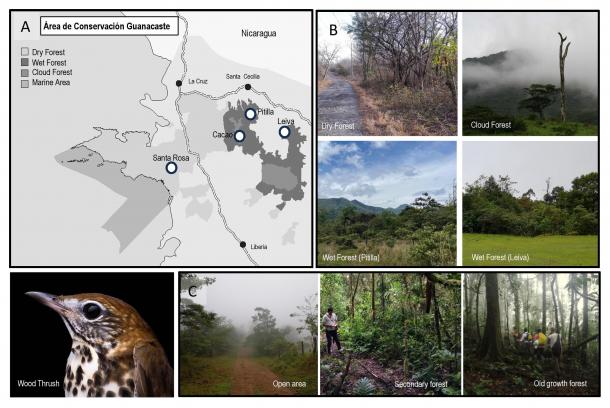
Study sites in the Área de Conservación Guanacaste (ACG): Santa Rosa, Volcán Cacao, Pitilla Biological Station, and Leiva Biological Station, located in Northern Costa Rica. B. Pictures of the four study locations showing the different forest types (dry forest, cloud forest, and wet forest). C. Pictures of three different vegetation structure sites in Pitilla Biological Station (wet forest). A picture of the study species, Wood Thrush (Hylocichla mustelina), is included in the figure (Photo: Adrian Delgado).
In a new paper in the journal Revista de Biología Tropical/International Journal of Tropical Biology, “Precipitation Explains Wood Thrush (Hylocichla mustelina) Occupancy Patterns in Northern Costa Rica,” Dr. Natalie Sánchez reports on the findings of three years’ worth of research on the Wood Thrush in Área de Conservación Guanacaste. The study, headed by Natalie, who is the project lead for ACG/GDFCF’s BioAve bird research project, aimed to understand the effects of environmental and forest structure variables on the occupancy of Wood Thrush in Northern Costa Rica. Wood Thrush are migratory birds that spend their non-breeding season in Costa Rica; they have seen dramatic declines in their population levels in recent years, primarily due to habitat fragmentation in their breeding and non-breeding habitats. The BioAve study area included sites in the tropical dry forest, cloud forest, and wet forests of ACG. Overall, the team found that Wood Thrush occupancy was best predicted by precipitation; as precipitation increased, so did the probability of Wood Thrush occupancy. The conclusion of the team was that the “Wood Thrush occupancy was best predicted by changes in precipitation considering a larger spatial scale. Its probability of presistence partially varied with precipation. An increase in persistence closer to Spring migration might be explained by the start of the breeding season of resident birds, potentially reducing territorial conflicts and conserving energy before migration. The long-term protection of wet forests in Northern Costa Rica is of paramount importance for the conservation of Wood Thrushes in their wintering grounds.” We are grateful for funding from the U.S. Fish and Wildlife Service’s Neotropical Migratory Bird Conservation Act program, the work of the BioAve researchers, as well as the parataxonomists Petrona Ríos, Calixto Moraga, Freddy Quesada, and Manuel Ríos who collected the Wood Thrush occupancy data at Estación Pitilla. The full article is here.

The BioAve team in 2021: (Lto R) Kathy Bonilla, Manuel Ríos, Petrona Ríos, Calixto Moraga, Freddy Quesada, and Natalie Sánchez.